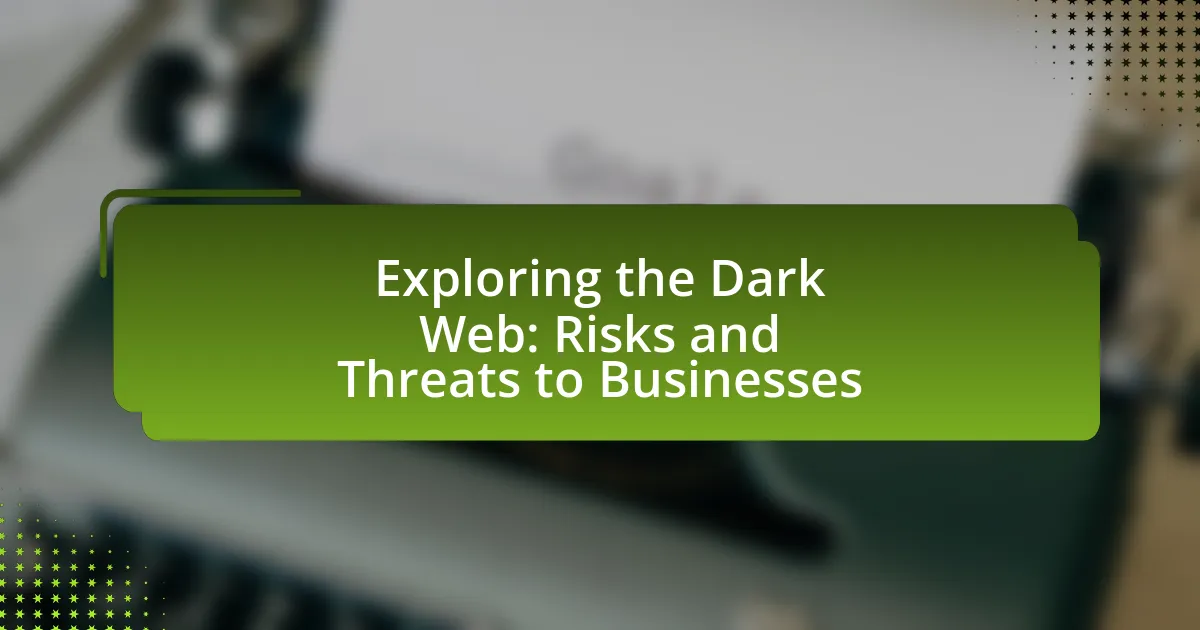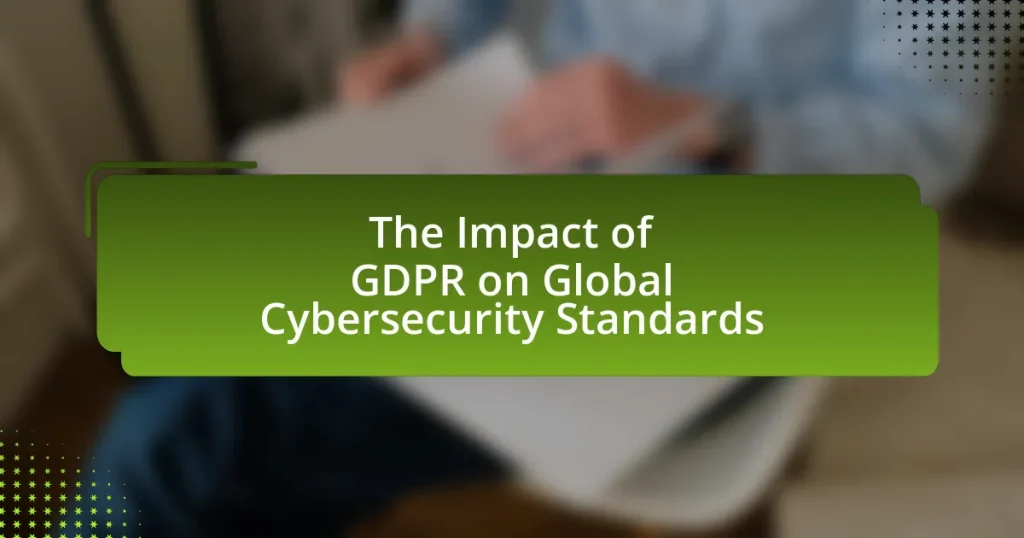The Dark Web is a hidden segment of the internet that poses significant risks to businesses, including data breaches, cybercrime, and the sale of stolen information. This article explores the distinctions between the Dark Web, Surface Web, and Deep Web, detailing how the Dark Web is accessed and the types of illicit activities prevalent within it. It highlights the potential impacts on business operations, including reputational damage and financial losses, while emphasizing the importance of cybersecurity measures and employee training to mitigate these risks. Additionally, the article outlines strategies for monitoring Dark Web activities and responding to identified threats, providing a comprehensive overview of the challenges businesses face in relation to this hidden online environment.
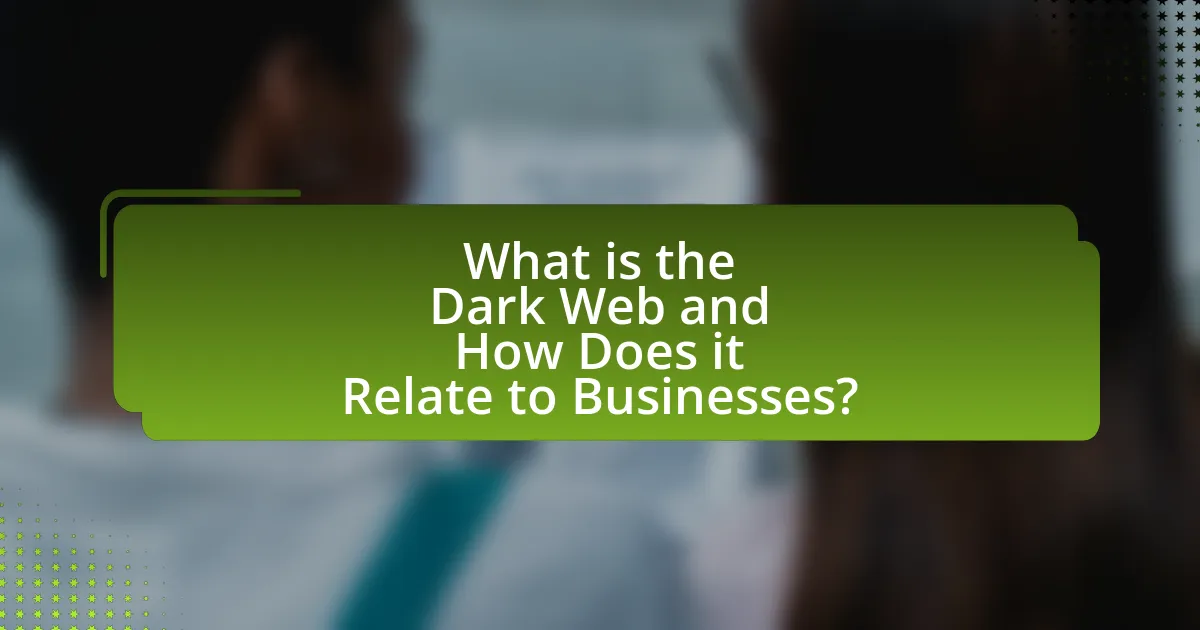
What is the Dark Web and How Does it Relate to Businesses?
The Dark Web is a part of the internet that is not indexed by traditional search engines and requires specific software, such as Tor, to access. It relates to businesses primarily through the risks it poses, including data breaches, cybercrime, and the sale of stolen information. For instance, a 2021 report by Cybersecurity Ventures estimated that cybercrime costs businesses over $6 trillion annually, with a significant portion of these activities facilitated by the Dark Web. Additionally, businesses may find their proprietary data or customer information being sold on Dark Web marketplaces, which can lead to reputational damage and financial loss.
What distinguishes the Dark Web from the Surface Web and Deep Web?
The Dark Web is distinguished from the Surface Web and Deep Web by its intentional anonymity and the use of specific software, such as Tor, to access it. The Surface Web consists of publicly accessible websites indexed by search engines, while the Deep Web includes unindexed content, such as databases and private networks, that is not accessible through standard search engines. In contrast, the Dark Web is a small portion of the Deep Web that has been intentionally hidden and is often associated with illegal activities, requiring specialized tools for access. This distinction is supported by the fact that the Dark Web hosts marketplaces for illicit goods and services, which are not found on the Surface Web or the majority of the Deep Web.
How is the Dark Web accessed and what tools are required?
The Dark Web is accessed primarily through specialized software, with the most common tool being the Tor browser. This browser enables users to connect to .onion websites, which are not indexed by traditional search engines and require the Tor network for access. The Tor network anonymizes user activity by routing internet traffic through multiple servers, making it difficult to trace the user’s location or identity. Additionally, users may employ Virtual Private Networks (VPNs) for an extra layer of security and anonymity while browsing the Dark Web. These tools are essential for accessing the Dark Web safely and securely, as they help protect user privacy and data from potential threats.
What types of content and activities are prevalent on the Dark Web?
The Dark Web is prevalent with illegal activities and content, including the sale of drugs, weapons, stolen data, and counterfeit goods. Research indicates that approximately 57% of the Dark Web consists of illicit marketplaces where users can anonymously buy and sell these items. Additionally, forums for hacking services, identity theft, and human trafficking are common, highlighting the risks associated with business exposure to these activities. The anonymity provided by the Dark Web facilitates these transactions, making it a significant concern for businesses regarding cybersecurity and legal implications.
Why do businesses need to be aware of the Dark Web?
Businesses need to be aware of the Dark Web because it is a hub for illegal activities that can directly impact their security and reputation. The Dark Web hosts marketplaces for stolen data, including customer information and corporate secrets, which can lead to data breaches and financial losses. For instance, a 2020 report by Cybersecurity Ventures estimated that cybercrime costs businesses over $6 trillion annually, with a significant portion stemming from activities originating in the Dark Web. Additionally, awareness of the Dark Web allows businesses to implement proactive security measures, such as monitoring for compromised credentials and understanding emerging threats, thereby safeguarding their assets and maintaining customer trust.
What are the potential impacts of the Dark Web on business operations?
The potential impacts of the Dark Web on business operations include increased risk of data breaches, exposure to illegal activities, and reputational damage. Businesses may face data breaches as sensitive information, such as customer data and intellectual property, can be bought and sold on the Dark Web, leading to financial losses and legal consequences. Additionally, companies may inadvertently become involved in illegal activities, such as the sale of counterfeit goods or the purchase of stolen data, which can result in legal repercussions. Reputational damage occurs when a business is associated with illicit activities, potentially leading to loss of customer trust and decreased sales. According to a 2021 report by Cybersecurity Ventures, cybercrime, including activities on the Dark Web, is projected to cost businesses over $10.5 trillion annually by 2025, highlighting the significant financial impact on operations.
How can the Dark Web affect a company’s reputation?
The Dark Web can significantly damage a company’s reputation by facilitating the sale of stolen data, including customer information and intellectual property. When sensitive information is leaked or sold on the Dark Web, it can lead to public distrust, loss of customer loyalty, and potential legal repercussions. For instance, a 2020 report by IBM found that the average cost of a data breach is $3.86 million, which can severely impact a company’s financial standing and public image. Additionally, negative associations with criminal activities linked to the Dark Web can tarnish a brand’s reputation, making it difficult for companies to regain consumer trust.
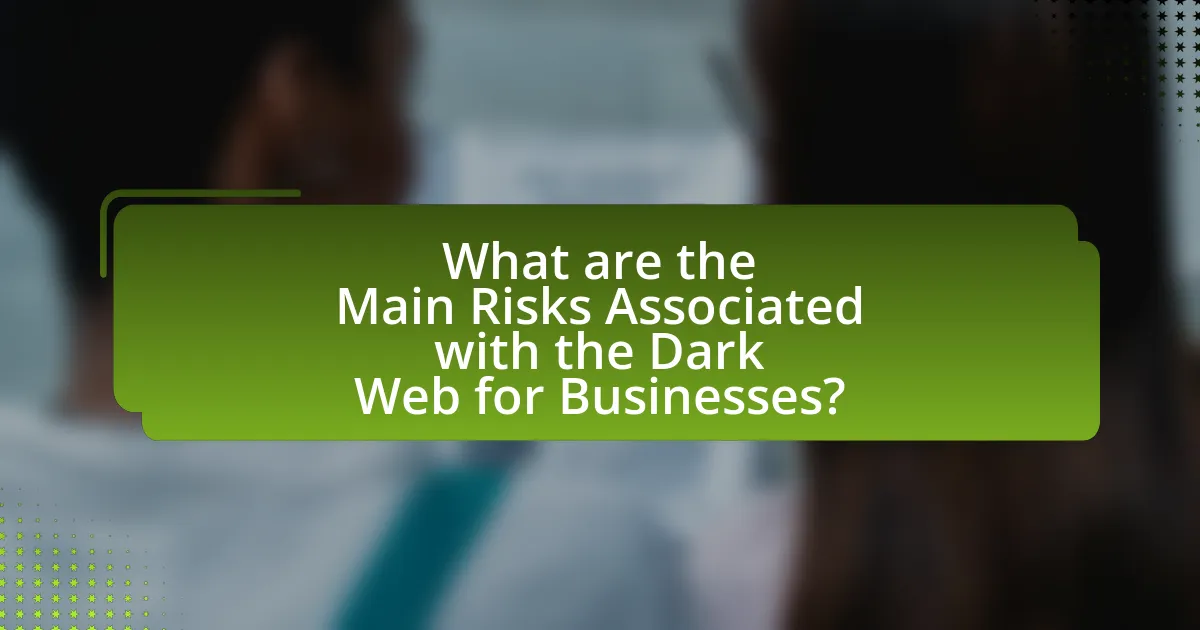
What are the Main Risks Associated with the Dark Web for Businesses?
The main risks associated with the Dark Web for businesses include data breaches, reputational damage, and exposure to illegal activities. Data breaches occur when sensitive information, such as customer data or intellectual property, is sold or traded on Dark Web forums, leading to financial losses and legal repercussions. Reputational damage can arise from public exposure of a company’s vulnerabilities or involvement in illicit activities, which can erode customer trust and brand integrity. Additionally, businesses may inadvertently engage with illegal services or products, resulting in legal consequences and potential criminal charges. According to a report by Cybersecurity Ventures, cybercrime is projected to cost businesses over $10 trillion annually by 2025, highlighting the significant financial impact of risks associated with the Dark Web.
What types of cyber threats originate from the Dark Web?
Cyber threats originating from the Dark Web include the sale of stolen data, malware distribution, and illicit services such as hacking for hire. The Dark Web serves as a marketplace where cybercriminals trade personal information, including credit card details and login credentials, which can lead to identity theft and financial fraud. Additionally, malware, including ransomware and spyware, is often available for purchase, enabling attackers to compromise systems and extort victims. Services like hacking for hire allow individuals to engage skilled hackers to conduct cyber attacks, further amplifying the risks to businesses. According to a report by the Cybersecurity and Infrastructure Security Agency (CISA), the Dark Web is a significant source of cybercrime, facilitating various illegal activities that threaten organizational security.
How do data breaches on the Dark Web occur?
Data breaches on the Dark Web occur primarily through the exploitation of vulnerabilities in systems, phishing attacks, and the sale of stolen data. Cybercriminals often target organizations using malware to infiltrate networks, extract sensitive information, and then sell this data on Dark Web marketplaces. For instance, a report by Verizon in 2022 indicated that 82% of data breaches involved a human element, such as social engineering tactics that trick employees into revealing credentials. Additionally, once data is compromised, it can be quickly disseminated across various forums and platforms on the Dark Web, making it accessible to other malicious actors.
What role do hackers play in the Dark Web ecosystem?
Hackers play a crucial role in the Dark Web ecosystem by facilitating illegal activities such as data breaches, identity theft, and the distribution of malware. They exploit vulnerabilities in systems to steal sensitive information, which is then sold on Dark Web marketplaces. For instance, a report by the cybersecurity firm McAfee indicates that the Dark Web is a hub for the sale of stolen credit card information, with prices ranging from $1 to $100 per card, depending on the card’s validity and balance. Additionally, hackers often provide services like hacking-for-hire, where they are contracted to carry out attacks on businesses or individuals, further perpetuating the cycle of cybercrime within this hidden online environment.
How can businesses be targeted through the Dark Web?
Businesses can be targeted through the Dark Web by cybercriminals who exploit vulnerabilities for illicit activities such as data breaches, ransomware attacks, and the sale of stolen information. Cybercriminals often use forums and marketplaces on the Dark Web to buy and sell sensitive data, including customer information, financial records, and intellectual property. For instance, a report by Cybersecurity Ventures estimates that cybercrime will cost businesses over $10.5 trillion annually by 2025, highlighting the significant financial threat posed by these activities. Additionally, tools and services for launching attacks, such as malware and hacking services, are readily available on the Dark Web, making it easier for malicious actors to target businesses effectively.
What are common tactics used by cybercriminals on the Dark Web?
Cybercriminals on the Dark Web commonly employ tactics such as phishing, ransomware distribution, and the sale of stolen data. Phishing involves tricking individuals into revealing sensitive information through deceptive emails or websites, which can lead to identity theft or financial loss. Ransomware distribution is another prevalent tactic, where malicious software encrypts a victim’s files, demanding payment for decryption. Additionally, the sale of stolen data, including credit card information and personal identities, is a significant activity, with reports indicating that the Dark Web hosts numerous marketplaces dedicated to such transactions. These tactics are supported by the anonymity provided by the Dark Web, making it difficult for law enforcement to track and apprehend offenders.
How do phishing attacks relate to Dark Web activities?
Phishing attacks are often facilitated by activities on the Dark Web, where stolen personal information, credentials, and phishing kits are bought and sold. Cybercriminals utilize the Dark Web to acquire tools and data that enhance their phishing schemes, making these attacks more sophisticated and harder to detect. For instance, a report by the Anti-Phishing Working Group indicates that the availability of phishing kits on the Dark Web has increased, allowing attackers to launch campaigns with minimal technical skills. This relationship underscores the interconnectedness of phishing and Dark Web activities, as the latter provides resources that directly support and amplify the former.
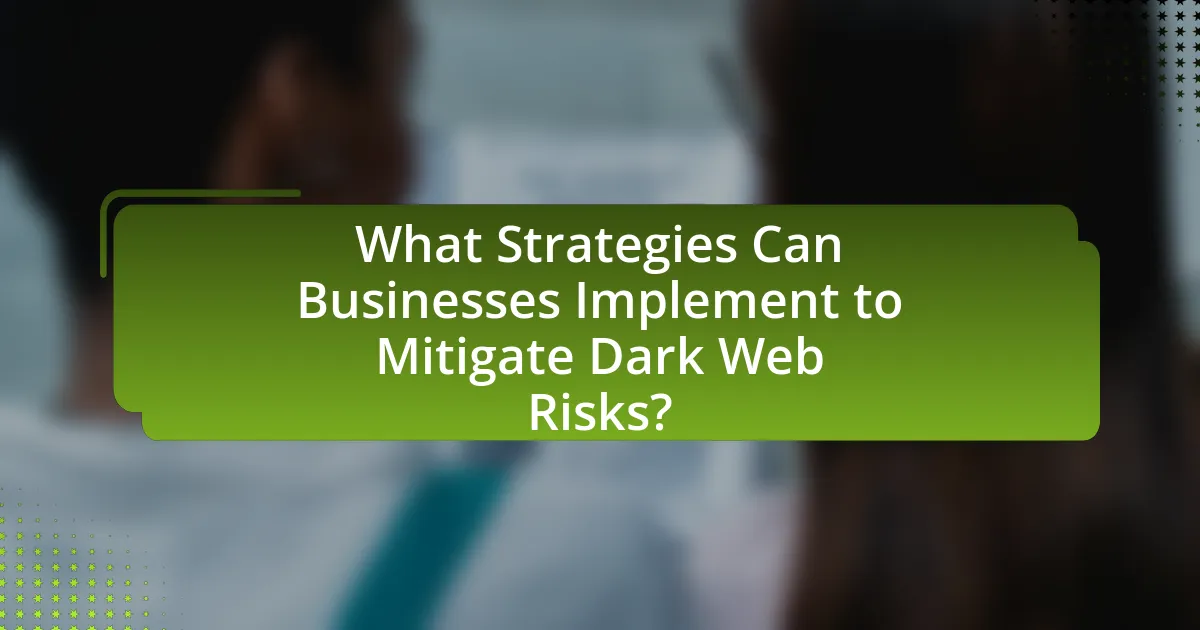
What Strategies Can Businesses Implement to Mitigate Dark Web Risks?
Businesses can mitigate dark web risks by implementing comprehensive cybersecurity measures, including regular monitoring of dark web activities, employee training on security awareness, and utilizing threat intelligence services. Regular monitoring allows businesses to identify compromised data or potential threats early, while employee training helps reduce the risk of human error, which is a significant factor in security breaches. Utilizing threat intelligence services provides businesses with insights into emerging threats and vulnerabilities, enabling proactive measures. According to a report by Cybersecurity Ventures, organizations that invest in threat intelligence can reduce the risk of data breaches by up to 30%.
What preventive measures can businesses take against Dark Web threats?
Businesses can implement several preventive measures against Dark Web threats, including regular monitoring of the Dark Web for compromised data, employee training on cybersecurity awareness, and the use of advanced security technologies. Regular monitoring helps identify if sensitive information, such as credentials or proprietary data, is being sold or discussed on Dark Web forums, allowing businesses to take immediate action. Employee training enhances awareness of phishing attacks and social engineering tactics commonly used to gain access to corporate networks. Advanced security technologies, such as intrusion detection systems and endpoint protection, provide an additional layer of defense against potential breaches. According to a report by Cybersecurity Ventures, the global cost of cybercrime is expected to reach $10.5 trillion annually by 2025, underscoring the importance of these preventive measures.
How can employee training reduce risks associated with the Dark Web?
Employee training can significantly reduce risks associated with the Dark Web by equipping staff with the knowledge to recognize and respond to potential threats. Training programs that focus on cybersecurity awareness help employees identify phishing attempts, social engineering tactics, and other malicious activities that may originate from the Dark Web. For instance, a study by the Ponemon Institute found that organizations with comprehensive security awareness training programs experienced 70% fewer successful phishing attacks. By fostering a culture of vigilance and providing practical skills, employee training minimizes the likelihood of breaches that could expose sensitive data or lead to financial loss.
What role does cybersecurity technology play in protecting businesses?
Cybersecurity technology plays a critical role in protecting businesses by safeguarding their digital assets from unauthorized access, data breaches, and cyberattacks. This technology includes firewalls, intrusion detection systems, and encryption methods that create multiple layers of defense against threats. For instance, according to a report by Cybersecurity Ventures, global cybercrime costs are projected to reach $10.5 trillion annually by 2025, highlighting the necessity for robust cybersecurity measures. By implementing these technologies, businesses can mitigate risks, ensure compliance with regulations, and maintain customer trust, ultimately protecting their reputation and financial stability.
How can businesses monitor Dark Web activities related to their operations?
Businesses can monitor Dark Web activities related to their operations by utilizing specialized Dark Web monitoring tools and services. These tools scan various Dark Web forums, marketplaces, and data leak sites for mentions of the business’s name, employee credentials, or sensitive data. For instance, companies like Recorded Future and DarkOwl provide comprehensive monitoring solutions that alert businesses to potential threats, such as data breaches or discussions about their products. According to a report by Cybersecurity Ventures, 60% of businesses that actively monitor the Dark Web can identify threats before they escalate, demonstrating the effectiveness of these monitoring strategies.
What tools are available for Dark Web monitoring?
Tools available for Dark Web monitoring include Terbium Labs, DarkOwl, and Recorded Future. Terbium Labs offers a service called Matchlight, which scans the Dark Web for compromised data and alerts businesses to potential breaches. DarkOwl provides access to a vast database of Dark Web content, enabling organizations to monitor threats and vulnerabilities. Recorded Future utilizes machine learning to analyze Dark Web data, helping businesses identify risks related to their brand and assets. These tools are designed to enhance cybersecurity by providing actionable intelligence from the Dark Web.
How can businesses respond to threats identified on the Dark Web?
Businesses can respond to threats identified on the Dark Web by implementing proactive monitoring and threat intelligence strategies. These strategies involve continuously scanning the Dark Web for mentions of the business, its employees, or sensitive data, which allows for early detection of potential breaches or reputational risks. According to a report by Cybersecurity Ventures, 60% of businesses that actively monitor the Dark Web can mitigate risks before they escalate into significant incidents. Additionally, businesses should establish incident response plans that include steps for addressing any threats discovered, such as notifying affected parties, enhancing security measures, and collaborating with law enforcement if necessary. This comprehensive approach not only helps in managing immediate threats but also strengthens overall cybersecurity posture.
What are the best practices for businesses to stay safe from Dark Web threats?
To stay safe from Dark Web threats, businesses should implement a comprehensive cybersecurity strategy that includes regular monitoring of the Dark Web for compromised data. This proactive approach allows organizations to identify potential breaches early. According to a report by Cybersecurity Ventures, 60% of small businesses that experience a cyber attack go out of business within six months, highlighting the critical need for vigilance.
Additionally, businesses should educate employees about phishing attacks and social engineering tactics commonly used to exploit vulnerabilities. The 2021 Verizon Data Breach Investigations Report indicates that 36% of data breaches involved social engineering, underscoring the importance of training.
Furthermore, employing advanced security measures such as multi-factor authentication, encryption, and regular software updates can significantly reduce the risk of unauthorized access. The Ponemon Institute’s 2021 Cost of a Data Breach Report found that organizations with fully deployed security automation experienced a 27% lower cost of a data breach, demonstrating the effectiveness of robust security practices.
Lastly, collaborating with cybersecurity experts or firms specializing in Dark Web monitoring can provide additional layers of protection and insights into emerging threats.
